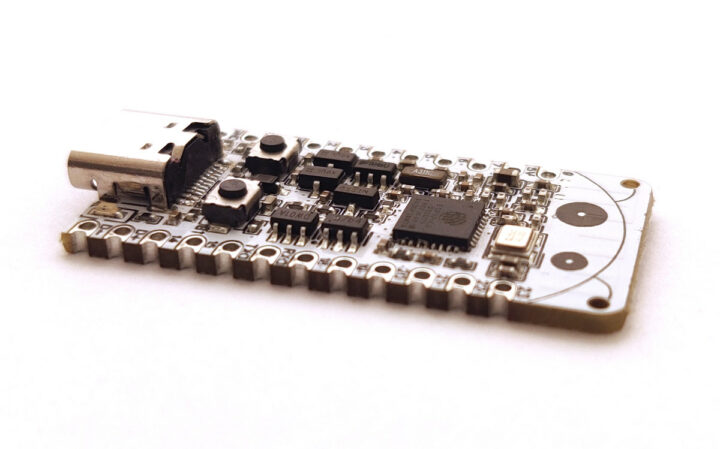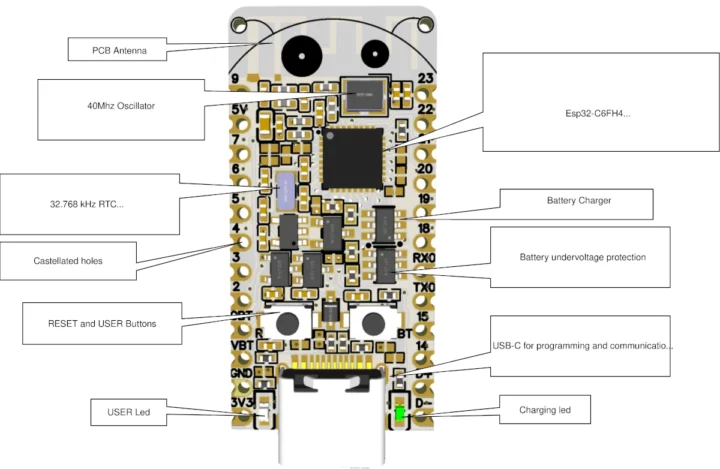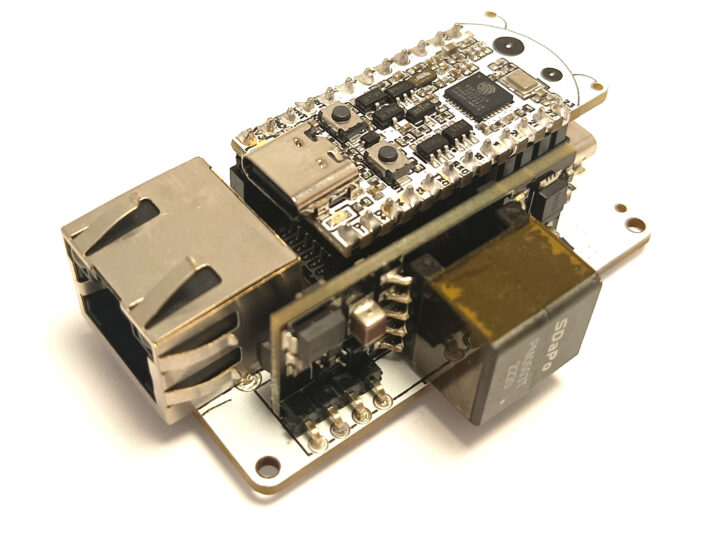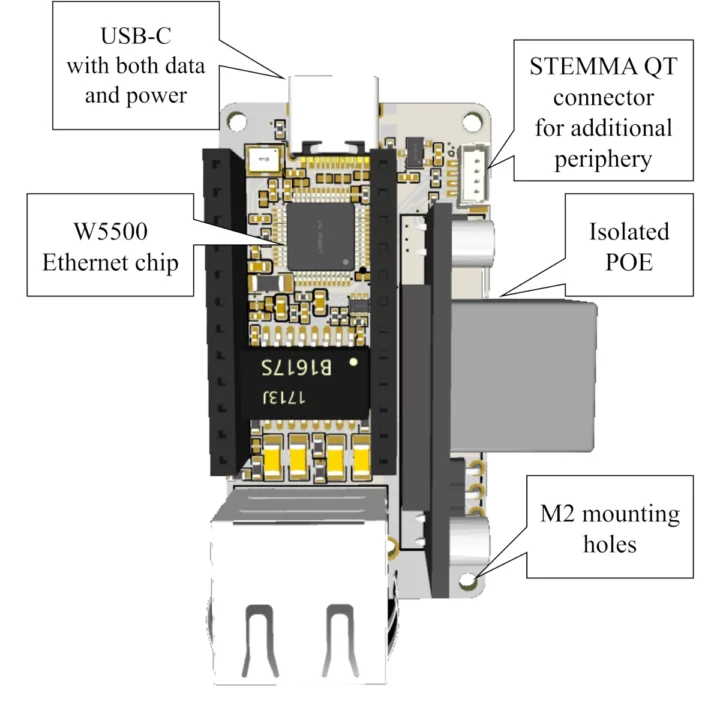We’ve already covered a range of ESP32-C6 boards, but none supporting Ethernet and PoE so far, and the ESP32-C6-Bug board brings that to the table thanks to the Esp32-Bug-Eth shield with a W5500 Ethernet chip, an RJ45 jack and a PoE power module.
Like other ESP32-C6 devices, the little board supports Wi-Fi 6, Bluetooth LE 5, as well as Thread and Zigbee through its 802.15.4 radio, but it also integrates some other interesting features such as castellated holes for easy soldering on a carrier board and support for LiPo batteries with built-in battery charging and protection circuits.
ESP32-C6-Bug board specifications:
- SoC – ESP32-C6FH4
- MCU cores
- 32-bit RISC-V core @ 160 MHz
- 32-bit RISC-V core @ 20 MHz low-power coprocessor can run tasks even when the main system is in deep sleep state
- Memory – 512 KB SRAM
- Storage – 4 MB Flash
- Wireless – WiFi 6, Bluetooth LE 5, and 802.15.4 radio (Zigbee, Thread, etc…)
- MCU cores
- USB – 1x USB Type-C port for power, programming, and data
- I/Os – 2x 12-pin headers with through and castellated holes
- Up to 19x GPIOs
- SPI, UART, I2C, I2S, PWM, SDIO, Motor Control PWM, 12-bit ADC, etc…
- Misc
- User-controlled LEDs
- External 32.768 kHz RTC oscillator and 40 MHz oscillator
- Reset and user-controlled buttons
- Antenna – PCB antenna
- Power Supply
- 5V via USB-C port
- LiPo battery support with
- Under-voltage and reverse-polarity protection
- On-board battery charging and level measurement w/ indicator LED
- 20 uA deep sleep power consumption (with timer wake-up)
- 700 mA low-noise LDO
- Dimensions – Small (and breadboard compatible)
While the board can be used standalone, some users will want to combine it with the Esp32-Bug-Eth shield to add both Ethernet and PoE support to create a tiny IoT gateway with WiFi 6, BLE, Thread, Zigbee, and Ethernet.
Esp32-Bug-Eth add-on board features:
- Wiznet W5500 Ethernet module
- USB – 1x USB-C port supporting both power and data
- Expansion – STEMMA-QT connector for connecting peripherals
- Power Supply
- 5V via USB-C port
- Isolated PoE support provided via SDAPO DP1435-5V module
The ESP32-C6-Bug can be programmed with the ESP-IDF framework or the Arduino IDE with various examples for the latter available on GitHub namely a blinky sample, an Ethernet sample to check wired connection when used in combination with the Esp32-Bug-Eth shield, an I2C OLED display sample, and a telegram bot pushing BMP280 sensor to Telegram over its Ethernet connection. At this time, Zigbee and Thread connectivity requires using the ESP-IDF, and it’s not implemented into the ESP32 Arduino core.
Hardware documentation including a datasheet, PDF schematics, the bill-of-materials (BoM), and 3D models can be found on a separate GitHub repository. Prokyber s.r.o also creates two 3D printable enclosures for the ESP32-C6-Bug board only and the combo with the Ethernet shield that you’ll find on Thingiverse.
Prokyber s.r.o has launched the ESP32-C6-Bug board on Crowd Supply with a $1,500 funding goal. Rewards start at $29 for the ESP32-C6-Bug board only, and the Esp32-Bug-Eth shield adds an extra $34, meaning a complete system would cost $63 before shipping which may make the solution a hard sell. Shipping adds $8 to the US, and $18 to the rest of the world, and backers should expect their perks to ship by August 2024 as long as there aren’t any unexpected issues.

Jean-Luc started CNX Software in 2010 as a part-time endeavor, before quitting his job as a software engineering manager, and starting to write daily news, and reviews full time later in 2011.
Support CNX Software! Donate via cryptocurrencies, become a Patron on Patreon, or purchase goods on Amazon or Aliexpress








